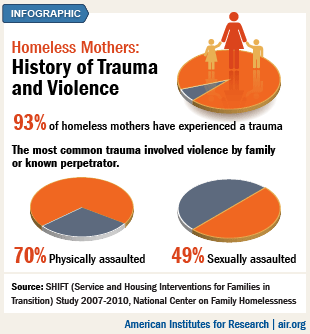This question came from Jackie via our latest website survey.
While most homelessness is a one-time event caused by a variety of complex and interrelated factors, many studies have found that housing and other “adverse events” play a critical role in child development and have highlighted family homelessness as a very serious issue.
Aratani’s 2009 report found that children with experiences of homelessness exhibit more mental health and behavioural issues, and do poorer in school. Furthermore, “children who have been exposed to violence and/or trauma display increased aggression, depression, anxiety, symptoms of PTSD and general mental health difficulties.” As the writers of “Permanent Supportive Housing for Families with Multiple Needs” stated: “Unfortunately, many of the associated outcomes of housing instability for children, including brain development and school performance produce the risk factors for homelessness later in life, therefore contributing to multigenerational homelessness.”
Multigenerational homelessness is not easy to trace or quantify, and as such, there’s no single set of statistics for me to give you; but here are a few findings from some existing research:
- One 1997 study on homelessness in families headed by women found that 14.2% of respondents had a female caretaker who had been homeless, and 10.3% had a primary male caretaker who was homeless — though neither was identified as an “independent factor.” (Foster care and drug use, however, were.)
- Koegel et al.’s 1995 study on childhood risk factors for homelessness found that of participating adults experiencing homelessness: 40% reported some form of housing problem or disruption during childhood. (13% lived in public or subsidized housing, 17% lived in crowded homes, 5% were evicted, 3% experienced homelessness with their families, and 17% reported homeless/ runaway experiences during childhood.)
- In the tri-annual Wilder Surveys on homelessness in Minnesota, 34% of surveyed homeless parents had themselves experienced homelessness as a child – up from 25% in 2006.
- Chamberlain and Johnson identified youth homelessness as a primary pathway into adult homelessness – what they call the “youth to adult” stream – which affected 35% of adults experiencing homeless in their study. Of this 35%, 85% experienced long-term homelessness.
Beyond just homelessness
What much of the research concludes is that it is not necessarily homelessness itself that causes future homelessness, but the factors that cause homelessness in the first place – a combination of poverty, lack of affordable housing, substance abuse issues, etc. Family and partner conflict and/or violence is also often a factor, as shown in the infographic from SHIFT (right).
A study by Shinn et al. on shelter use in New York City found a variety of individual factors contributed to requests for shelter use, including childhood “disruptions” (like being in foster care), but no one factor type was more prominent than others. The researchers also found that access to subsidized housing was the only common factor among the 75% of families who were eventually stably housed.
80% of respondents in Baker Collins’ study stated that what happened to them as children led to their chronic homelessness, and 75% had been physically and/or sexually abused. 40% spent time in foster care, group homes, or custody; and another 40% said they were sent away from home.
This post is part of our Friday "Ask the Hub" blog series. Have a homeless-related question you want answered? E-mail us at thehub@edu.yorku.ca and we will provide a research-based answer.
Photo credit: SHIFT study


